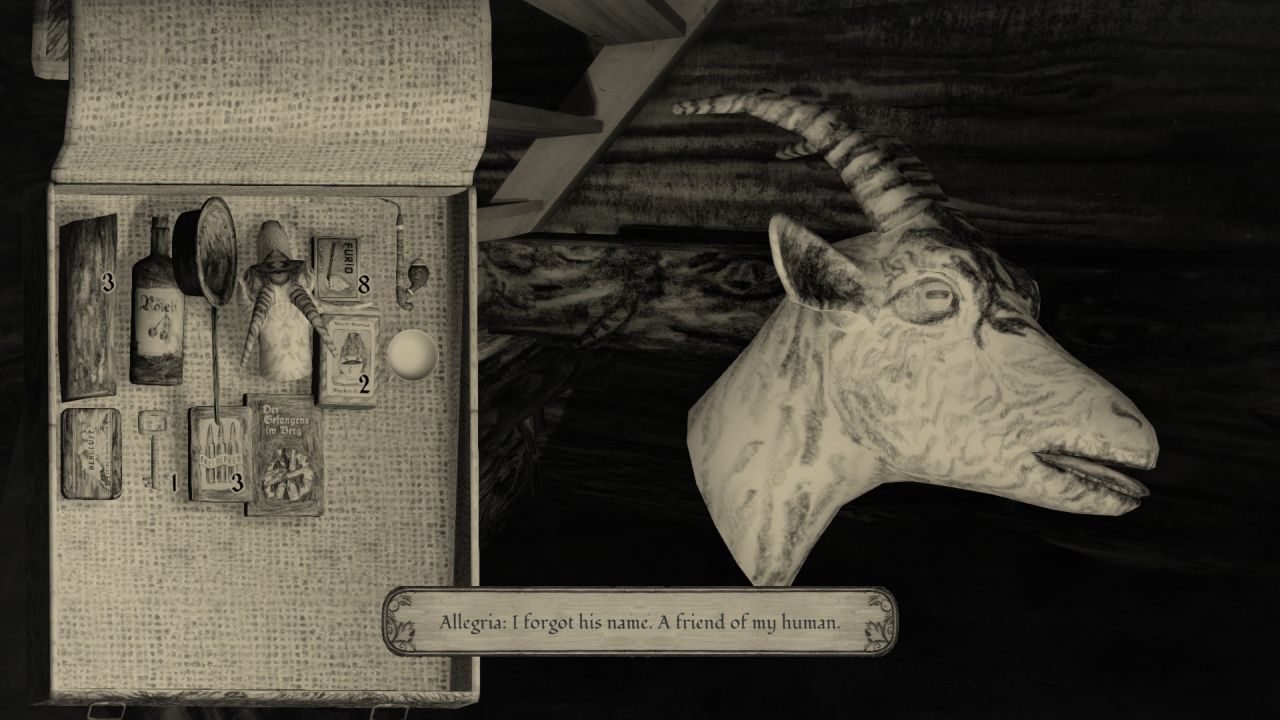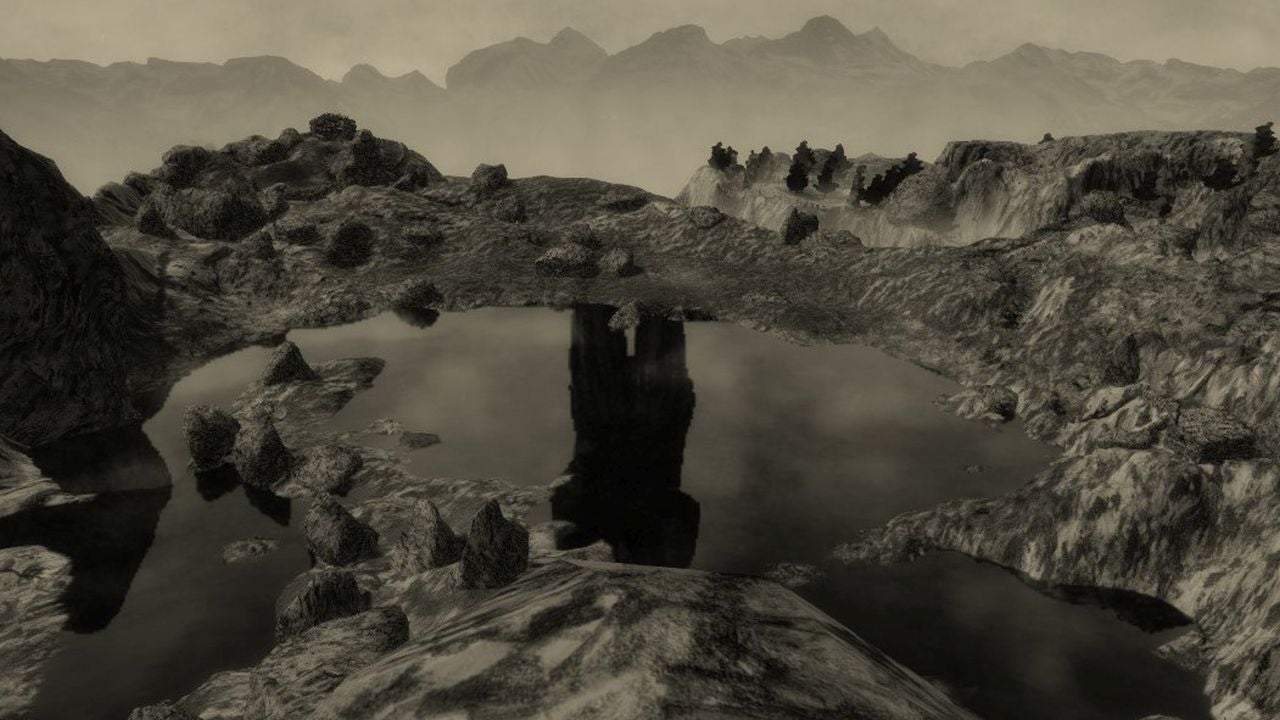One of the first things that may strike you about Mundaun, a very unsettling horror game that released earlier this year, is just how comfortable with weirdness it is. There are hay people hunting you in the night, monstrous masks inspired by traditional Swiss carnival costumes, and the decapitated head of the goat Allegria, bleating and chattering from your backpack.
Many horror games either try to establish a sense of mundane familiarity in a recognisable, contemporary world before shattering that familiarity, or else rely on the dusty, done-to-death setting of haunted manors. In most cases, neither approach does much to surprise. Horror often relies on the grotesque, but Mundaun’s weirdness is different. It is an earthy kind of weirdness, a strangeness with roots so deep that it might be confused with familiarity. It’s a horror that smells not of blood, but of hay and dung, snow and soot.
It’s folk horror that embraces traditional aesthetics and themes that modern games often reject wholesale: the loneliness of alpine landscapes, the centrality of a rural and simple kind of Christianity stripped of all theological intricacies, as well as old folk tales, beliefs and customs.
At the heart of all this weirdness lies a very old and familiar story: the devil appears to simple folk in desperate need and proposes a tempting deal. He can provide an easy way out of an unsolvable dilemma, in exchange for a small favour to be repaid at a later date. That small favour, of course, is usually an unbaptised soul. Left with few other options, the people agree reluctantly, then attempt to trick the adversary by taking advantage of the vague terms of the deal, so instead of the soul of a human or an unbaptised child, they fob off the devil with a goat or other animal.

It’s the basic blueprint for many folk tales. You apparently can get a lot of things done with a little help from your infernal friend. In Mundaun, the devil buries advancing enemy soldiers under an avalanche. According to the legends surrounding the Teufelsbrücke or devil’s bridge of the Schöllenen Gorge, he built a daring bridge after all human efforts proved in vain. And in the classic horror novella Die Schwarze Spinne – The Black Spider – he comes to the rescue of the serfs of a small village subjected to the harsh whims and demands of their lord, using his dark magic to perform the backbreaking labour that would have left the fields untended and thus have led to the starvation of the whole community.
The Black Spider, written by Swiss author Jeremias Gotthelf and published in 1842, is sometimes considered a foundational text of weird fiction and has been cited as a major inspiration for Mundaun by its creator Michel Ziegler. The story centers on the headstrong peasant woman Christine, who agrees to give up the next newborn child in the village to the devil in exchange for his help. The devil then seals the deal with a kiss on Christine’s cheek.
“Mundaun may not have demon spiders, but it shares a preoccupation with many of the traits of folk stories.”
When Christine and the other villagers try to deny the devil his due by hurriedly baptising every child as soon as it has been born, the spot where the devil kissed Christine’s cheek starts to swell and grow. The agonising growth takes on the shape of a black spider, which in turn summons an army of tiny deadly spiders terrorising the village. Christine is eventually turned into the black spider and wreaks havoc until one woman imprisons the spider in a window post and seals it with a plug, where it remained, waiting, for hundreds of years.
There’s much more to it, but you can already see the echoes. Mundaun may not have demon spiders, but it shares a preoccupation with many of the traits of folk stories, like its Christian rural setting, the concerns of common people and a deal with the devil, a love for weird and grotesque imagery, as well as an interest in the consequences of past sins for future generations.

Mundaun and the stories that inspired it grew from a world where the lofty ideas of religion have seeped deep into the soil, where any attempt to disentangle superstition from religion must fail, and where the devil is a part of daily life and may be encountered in the guise of an old man on a lonely alp. This world has a sense of intimacy and closeness, but also of closed-off-ness and isolation. We are alone with primal forces. Mundaun drives home this intimacy and isolation, distancing us from the here and now. It does so not only through its lonely landscapes, but also through its hand-drawn, black-and-white aesthetic showing a bygone age, and its use of the Romansh language, which is spoken by around 40,000 people, mostly in the Swiss canton of Graubünden or Grischun.
Nothing of this is to say that Mundaun is somehow old fashioned or outdated. Some of its weirdest and most surprising moments are often playfully experimental or postmodern. There are giant, unexplained reflections in mountain lakes, strangely deconstructed drawings that look like texture maps, art exhibitions attended by ashen statues, and a morbid and self-conscious sense of humour. It also has none of the simple Christian moralism or didactic allegorical bent of a story like The Black Spider.
It’s not a straightforward continuation of an old tradition, and neither could it be. The old folk tales have shifted into new contexts, retold and engaged with not by peasants living off the soil and in relative isolation, but mostly by secular citydwellers connected through high-speed internet access, yet at the same time also cut off from the traditions that defined the lives of their not-too-distant ancestors. Mundaun shows how rich and weird a harvest it can yield if those two worlds are allowed to meet.
